
Saidai-ji (西大寺) or the "Great Western Temple" is a Buddhist temple that was once one of the powerful Seven Great Temples in the city of Nara, Nara Prefecture, Japan. The temple was first established in AD 765 as a counterpart to Tōdai-ji and it is the main temple of the Shingon Risshu (真言律宗) sect of Buddhism after the sect's founder, Eison (叡尊), took over administration in 1238. It has undergone several reconstruction efforts since then during the succeeding centuries.

Daisen-ji (大山寺) is a Buddhist temple located in the town of Daisen, Tottori Prefecture, Japan. It belongs to the Tendai sect of Japanese Buddhism, and its honzon is a statue of Jizo Bosatsu.The temple is built on the slopes of Daisen. The Amida-dō and other parts of the temple are designated National Important Cultural Properties. The temple precincts are protected as a National Historic Site

Dōjō-ji (道成寺) is a Tendai school Buddhist temple in the town of Hidakagawa, Wakayama Prefecture, Japan. Founded in the Nara period, it has given its name to a number of plays, most notably the Noh drama Dōjōji. The temple has numerous statues which are designated National Treasures, or Important Cultural Properties, as well as several structures with the Important Cultural Property designation. The precincts of the temple were designated a National Historic Site in 2013.
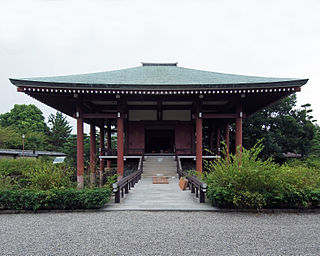
Chūgū-ji (中宮寺) is a temple in Nara Prefecture, Japan, that was founded as a nunnery in the seventh century by Shōtoku Taishi. Located immediately to the northeast of Hōryū-ji, its statue of Miroku and Tenjukoku mandala are National Treasures.

Mutsu Kokubun-ji (陸奥国分寺) is a Buddhist temple in Wakabayashi-ku, Sendai, Japan, belonging to the Shingon-shū Chizan-ha sect, and is the provincial temple ("kokubunji") of former Mutsu Province. The grounds of the temple are a National Historic Site. and one of its structures, the early Edo period Yakushi-dō (薬師堂) is an Important Cultural Property.
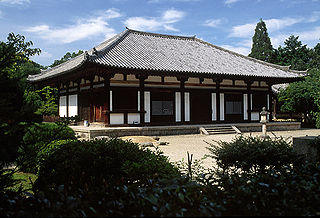
Akishino-dera (秋篠寺) is a Buddhist temple in Nara, Japan. Founded in the eighth century, its Kamakura-period Hondō is a National Treasure.

Byakugō-ji (白毫寺) is a Buddhist temple in Nara, Japan. A number of wooden statues of the Heian and Kamakura periods have been designated Important Cultural Properties and the temple's five-coloured camellias are a Prefectural Natural Monument.
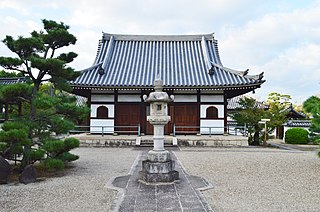
Yachū-ji (野中寺) is a Buddhist temple located in the city of Habikino, Osaka Prefecture, Japan, belonging to the Kōyasan Shingon-shū branch of Shingon Buddhism. Its main image is a statue of Yakushi Nyorai. The temple is also popularly known as Naka-no-Taisi (中の太子) as it is located in between the temples of Eifuku-ji and Taiseishōgun-ji, which also claim a connection with Prince Shōtoku. The temple precincts are designated a National Historic Site
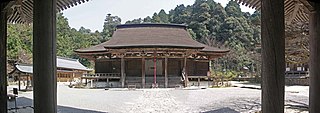
Saimyō-ji (西明寺), also known as Kotō-sanzan Saimyōji (湖東三山西明寺) or as Ryūōzan Saimyōji (龍應山西明寺) is a Buddhist temple of the Tendai sect located in the town of Kōra, Shiga Prefecture, Japan. The honzon of the temple is Yakushi Nyōrai, the Buddha of healing. The temple was founded in the early Heian period and together with Kongōrin-ji in Aishō and Hyakusai-ji in Higashiōmi the temple forms a group of three temples known as Kotō-sanzan. The complex includes several National Treasures and a garden designated as National Place of Scenic Beauty.

Eison (叡尊) (1201–1290) was a Japanese Buddhist monk who founded the Shingon Risshu sect.
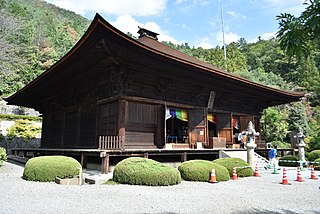
Daizen-ji (大善寺) is a Buddhist temple belonging to the Shingon school of Japanese Buddhism, located in the city of Kōshū, Yamanashi, Japan. Its main image is a hibutsu statue of Yakushi Nyōrai, shown to the public every five years,

Takidan-ji (瀧谷寺) is a Buddhist temple belonging to the Shingon-shū Chizan-ha sect located in the city of Sakai, Fukui, Japan in the Hokuriku region of Japan. Its main image is a statue of Yakushi Nyōrai, which the temple claims was carved by the Nara period shugendō monk Taichō. The temple is noted for its Japanese garden.

Kongōrin-ji (金剛輪寺), also known as Matsuo-dera (松尾寺) is a Buddhist temple of the Tendai sect located in the town of Aishō, Shiga Prefecture, Japan. The honzon of the temple is Kannon Bosatsu. The temple was founded in the early Heian period and together with Saimyō-ji in Kōra and Hyakusai-ji in Higashiōmi the temple forms a group of three temples known as Kotō-sanzan. The complex includes a Main Hall that is designated as National Treasures, which contains many statues from the Heian period onwards which are Important Cultural Properties and a garden designated as National Place of Scenic Beauty.

Zensui-ji (善水寺) is a Buddhist temple in the Iwane neighborhood of the city of Konan, Shiga Prefecture, Japan. It belongs to the Tendai school of Japanese Buddhism. Its main image is a hibutsu statue of Yakushi Nyōrai, which was carved in 993. Its Hondō is a National Treasure.

Chōjū-ji (長寿寺) is a Buddhist temple in the city of Konan, Shiga Prefecture, Japan. It belongs to the Tendai school of Japanese Buddhism. Its main image is a hibutsu statue of Jizō Bosatsu. Its Hondō is a National Treasure.: It is also referred to as Higashi-dera (東寺), whereas the temple of Jōraku-ji (長寿寺) is referred to as Nishi-dera (西寺).

The Bitchū Kokubun-ji (備中国分寺) is an Omuro-branch Shingon Buddhist temple located in what is now the Kamibayashi neighborhood of the city of Sōja, Okayama, Japan. Its main image is a statue of Yakushi Nyorai. It claims to be the successor to one of the provincial temples per the system established by Emperor Shōmu during the Nara period for the purpose of promoting Buddhism as the national religion of Japan and standardising Yamato rule over the provinces.
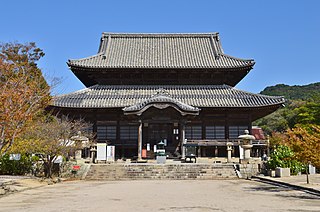
Suō Kokubun-ji (周防国分寺) is a Shingon-sect Buddhist temple in the Kokubunji neighborhood of the city of Hōfu, Yamaguchi, Japan. It is one of the few surviving provincial temples established by Emperor Shōmu during the Nara period. Due to this connection, the foundation stones of the Nara period temple overlapping the present day complex were designated as a National Historic Site in 1957.

Kontai-ji (金胎寺) is a Buddhist temple located in the Harayama neighborhood of the town of Wazuka, Kyoto Prefecture, in the Kinai region of Japan. The temple belongs to the Daigo-ji branch of the Shingon-sect of Japanese Buddhism and its honzon is a statue of Miroku Bosatsu. The temple precincts were a National Historic Site in 1934.
























